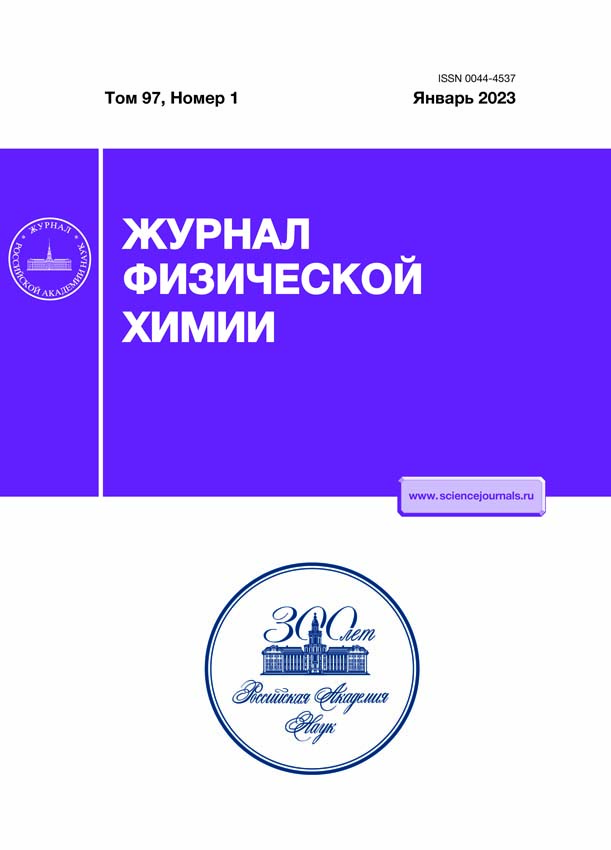Experimental Investigation and Thermodynamic Modelling of Ag–In–Pd Ternary System
- Autores: Khoroshilov A.V.1, Kuznetsov V.N.2, Pavlenko A.S.2, Ptashkina E.A.2, Zhmurko G.P.3, Kabanova E.G.2, Kareva M.A.2
-
Afiliações:
- Institute of General and Inorganic Chemistry
- Chemical Faculty, Moscow State University
- Institute of General and Inorganic Chemistry, Russian Academy of Sciences
- Edição: Volume 97, Nº 1 (2023)
- Páginas: 46-54
- Seção: CHEMICAL THERMODYNAMICS AND THERMOCHEMISTRY
- ##submission.dateSubmitted##: 27.02.2025
- ##submission.datePublished##: 01.01.2023
- URL: https://innoscience.ru/0044-4537/article/view/668867
- DOI: https://doi.org/10.31857/S0044453723010235
- EDN: https://elibrary.ru/BCRZNU
- ID: 668867
Citar
Texto integral
Resumo
Phase equilibria in Ag–In–Pd ternary system were studied using Scanning electron microscopy, Energy-dispersive X-ray spectroscopy (EDX) and X-Ray diffraction method (XRD). The solubilities of the third components in Ag–In and In–Pd binary phases were established, as well as composition ranges (from 4 to 17.5 at % Ag at 25 at % In) and crystal structure of τ ternary compound (Al3Ti). New thermodynamic assessment of Ag–In–Pd ternary system was performed, basing on the published experimental data and those obtained in the present work. Good agreement was achieved between the calculation results and the experimental data on phase equilibria and thermodynamic properties of the phases. The results of the calculation reproduce well experimental DTA/DSC data of three samples (the data were not included into the optimization). This additionally supports the correctness of the obtained thermodynamic description.
Palavras-chave
Sobre autores
A. Khoroshilov
Institute of General and Inorganic Chemistry
Email: kabanovaeg@gmail.com
Moscow, Russia
V. Kuznetsov
Chemical Faculty, Moscow State University
Email: kabanovaeg@gmail.com
Moscow, Russia
A. Pavlenko
Chemical Faculty, Moscow State University
Email: kabanovaeg@gmail.com
Moscow, Russia
E. Ptashkina
Chemical Faculty, Moscow State University
Email: kabanovaeg@gmail.com
Moscow, Russia
G. Zhmurko
Institute of General and Inorganic Chemistry, Russian Academy of Sciences
Email: kabanovaeg@gmail.com
Moscow, Russia
E. Kabanova
Chemical Faculty, Moscow State University
Email: kabanovaeg@gmail.com
Moscow, Russia
M. Kareva
Chemical Faculty, Moscow State University
Autor responsável pela correspondência
Email: kabanovaeg@gmail.com
Moscow, Russia
Bibliografia
- Shin H.-J., Kwon Y.H., Seol H.-J. // J. Mech. Behav. Biomed. Mater. 2020. V. 107. P. 103728. https://doi.org/10.1016/j.jmbbm.2020.103728
- Zemanová A., Semenova O., Kroupa A. et al. // Monatsch. Chem. 2005. V. 136. № 11. P. 1931.https://doi.org/10.1007/s00706-005-0384-x
- Zemanová A., Semenova O., Kroupa A. et al. // Intermetallics. 2007. V.15. № 1. P. 77. https://doi.org/10.1016/j.intermet.2006.03.002
- Luef C., Flandorfer H., Ipser H. // Metall. Mater. Trans. A. 2005. V. 36. № 5. P. 1273. https://doi.org/10.1007/s11661-005-0219-8
- Garzeł G., Zabdyr L.A. // Rare Met. 2006. V. 25. № 5. P. 587. https://doi.org/10.1016/S1001-0521(06)60104-6
- STOE WinXPow, version 2.24. Darmstadt электронный ресурс. – Software package (10.2 Mb). Germany: STOE & Cie GmbH; 2009.
- Thermo-Calc®-Academic (Version 2022а) электронный ресурс. – Software package (235 Mb). – Stockholm: Thermo-Calc® Software AB.; 2022.
- Saunders N., Miodovnik A.P. CALPHAD (Calculation of Phase Diagrams): A comprehensive guide. London: Pergamon, 1998. 479 p.
- Kohlmann H., Ritter C. // Z. Anorg. Allg. Chem. 2009. V. 635. P. 1573. https://doi.org/10.1002/zaac.200900053
- Bhan S., Schubert K. // J. Less-Common Met. 1969. V. 17 P. 73. https://doi.org/10.1016/0022-5088(69)90038-1
- Ptashkina E.A., Kabanova E.G., Kalmykov K.B. et al. // J. of Alloys Comps. 2020. V. 845. P. 156166. https://doi.org/10.1016/j.jallcom.2020.156166
- Muzzillo C.P., Anderson T. // J. Mater. Sci. 2018. V. 53. № 9. P. 6893. https://doi.org/10.1007/s10853-018-1999-8
- Pavlenko A.S., Kabanova E.G., Kuznetsov V.N. // Russ. J. Phys. Chem. A. 2020. V. 94. № 13. P. 2691. https://doi.org/10.1134/s0036024420130178
- Jiang C., Liu Z.K. // Metall. Mater. Trans. A. 2002. V. 33. № 12. P. 3597. https://doi.org/10.1007/s11661-002-0235-x
Arquivos suplementares













